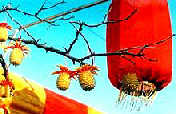
Originating in the East Han Dynasty (25-220), Chinese colored lanterns reached their peak during the Tang (618-907) and Song (960-1279) dynasties, when people then were just as enthusiastic in watching the colored lanterns as today's Chinese people are in watching the special TV New Year program during every Chinese Lunar New Year.
Originally, people hung colored lanterns in front of their doors to drive away evil spirits. But today, with society's development, the colored lantern has largely become a symbol of traditional Chinese culture, playing an even more important role in celebrations and ceremonies.
Four of the most famous styles of colored lanterns come from the capitalBeijingin North China,Suzhoucity in East China'sJiangsu Province, and Haining and Wenzhou cities in East China'sZhejiang Province.
Beijing
Beijing, as one of the nation's four famous ancient capitals, boasts some of the most exquisite and elegant-shaped colored lanterns made of select raw materials. The lanterns hanging in front of the Tian'anmen Square are representatives of royal lanterns. They are made of steel frames which are then covered by red silk. Both their top and bottom mouths are decorated withruyi(wish-granting scepter) patterns; their bottom mouths are also decorated with hanging golden tassels that shine beautifully and elegantly.
The best traditional Beijing palace lanterns require valuable rosewood as the skeleton and are usually covered with traditional-patterned thin silk or glass. Besides their original lighting function, the palace lanterns are also high works of art that are favored by Chinese lantern collectors. Palace lanterns are so named because they were first used in the palace. Now they are usually hung in halls or study rooms, for an added classic antique effect.

Suzhou
In contrast with Beijing royal colored lanterns, Suzhou-style colored lanterns usually have a rustic flavor. They boast a long history and a delicate beauty. Early in the Song Dynasty, colored lanterns developed into an individual crafts industry.
Suzhou lanterns vary greatly in shape, ranging from birds, flowers, and fishes to pavilions, terraces, towers and even human figures. Though the raw materials used are very simple, the artistic value is still high. Suzhou lanterns are known for their rich colorfulness, refined processing, ingenious structure, exquisite sculpture and grand magnificence. In raw material, the Suzhou lanterns can be classified as frameless, pearl or silk lanterns, while in shape, they can be categorized as table, pendant, wall, seated or hand lanterns.
The lanterns are a delicate combination of many artistic techniques likepaper cutting,papercarving, paperhanging, and drawing. Both the construction style of classicSuzhou Gardens, and the Wu-style painting in theMing Dynasty(1368-1644) influenced Suzhou colored lanterns, and helped form a unique artistic style. On the lanterns are paintings mainly of pavilions, pagodas and towers. Human figures, landscape, birds and flowers are used as decorations, forming a strong folk art flavor on the south ofYangtze River. Among Suzhou's various colored lanterns,zou ma deng(galloping horse lantern), with its famous ingenious design, is probably the most famous. The lantern has a revolving circle ofpaper-cutlanterns or other figures. When the candle is lit, the circulation caused by the fire will make the inner circle revolve. The story on the paper-cut can then be read with flowing pictures. Nowadays, Suzhou's lantern-making techniques has become more advanced, and though the custom of watching lanterns in theSpring Festivalhas largely disappeared, new colored lanterns incorporating the modern technology still attract people all over the country to buy lanterns in Suzhou.










